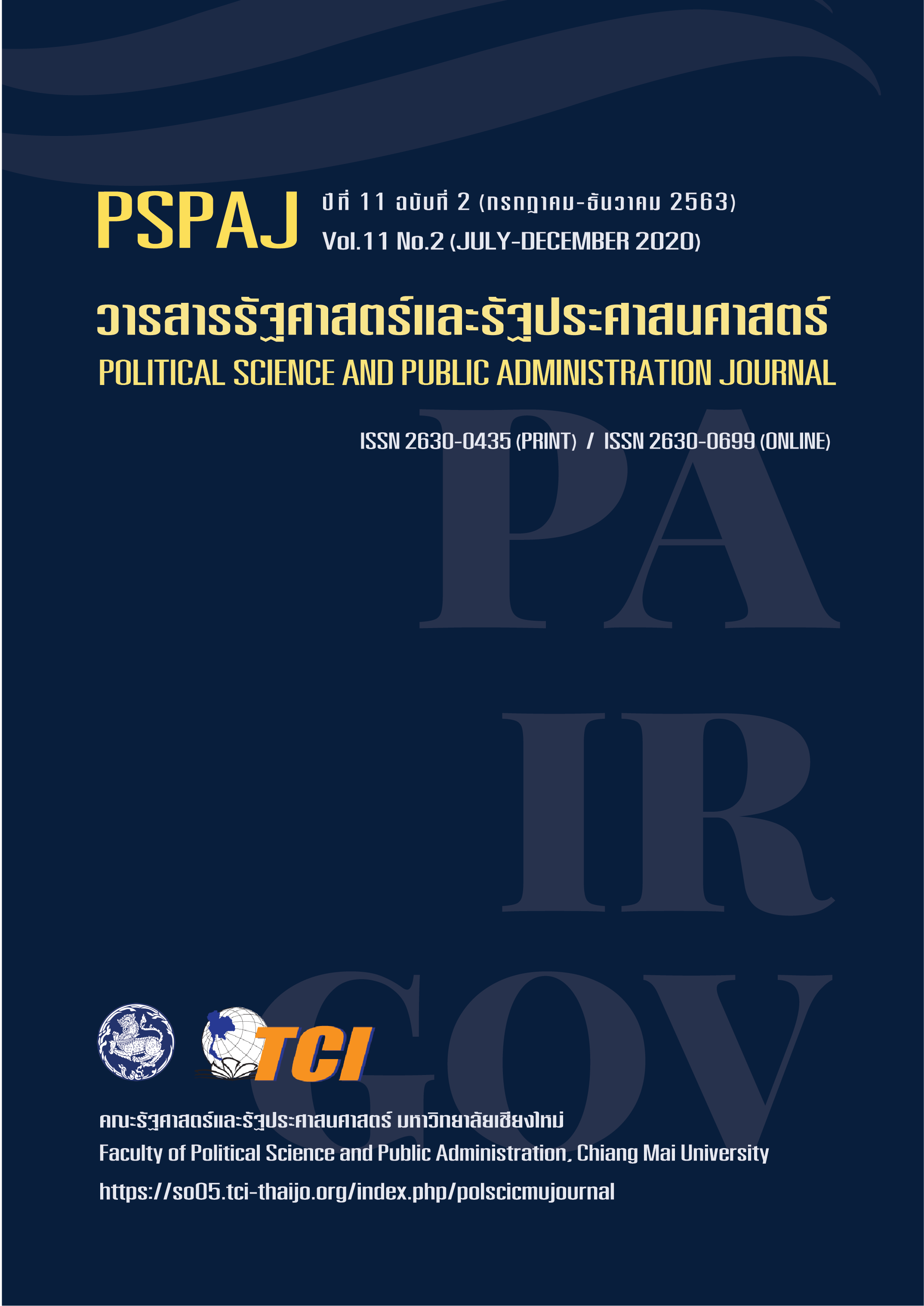A Trends and Directions of Red Car Taxi Service in Muang District, Chiang Mai Province
Main Article Content
Abstract
A study on “The Trends in the future of red taxi service in Muang District, Chiang Mai Province” has the objectives: 1) to study the area of issue and the factors that affect red taxi services, 2) to study the behavior, attitude and the needs of red taxi services, and 3) to analyze the trends in the future of red taxi services. This study uses quantitative methods as a tool through interview questionnaires with 30 red taxi drivers and questionnaires of 400 red taxi passengers. The study shows that red taxi service is a non-stationary service that monopolizes the public transportation system in Mueang Chiang Mai District. There is various problem with the red taxi services, particularly the quality of service that has been steadily declining. The factors that affect the red taxi service can be divided into five aspects: 1) service, 2) economic and social, 3) attitude and behavior of passengers, 4) Chiang Mai physicals, and 5) mass transit system policy in Chiang Mai. Moreover, this study shows that red car passengers have a negative attitude towards the red taxi service and when it comparing passengers’ attitude with the needs of red taxi services, it had negative value in all aspects. The future trends of red taxi service can still remain in Chiang Mai through a period of time.
Article Details
- เนื้อหาและข้อมูลที่ลงตีพิมพ์ในวารสารรัฐศาสตร์และรัฐประศาสนศาสตร์ถือเป็นข้อคิดเห็นและความรับผิดชอบของผู้เขียนบทความโดยตรง ซึ่งกองบรรณาธิการวารสารรัฐศาสตร์และรัฐประศาสนศาสตร์ ไม่จำเป็นต้องเห็นด้วย หรือร่วมรับผิดชอบใดๆ
- บทความและข้อมูล ที่ได้รับการตีพิมพ์ในวารสารรัฐศาสตร์และรัฐประศาสนศาสตร์ ถือเป็นลิขสิทธิ์ของวารสาร หากบุคคลหรือหน่วยงานใดต้องการนำข้อมูลไปใช้ประโยชน์ในทางวิชาการ ขอให้อ้างอิงแหล่งที่มาด้วย
References
กระทรวงการท่องเที่ยวและกีฬา. (2559). รายงานภาวะเศรษฐกิจการท่องเที่ยว. กรุงเทพฯ: กองเศรษฐกิจการท่องเที่ยวและกีฬา.
กองบรรณาธิการวอยซ์ทีวี. (2560). รู้จัก “รถแดงเชียงใหม่”เสน่ห์ หรือมาเฟียคู่เมืองท่องเที่ยว?. สืบค้นเมื่อ 25 พฤษภาคม 2560, จาก https://www.voicetv.co.th/read/466896
กานดา มณีโสภณ, ช่อทิพย์ วานิชย์หานนท์, ธรรมศักดิ์ ลออเอี่ยม, สมัย โตเจริญ, และนาถวดี วงศ์จันทร์. (2542). ความพึงพอใจของผู้ใช้บริการที่มีต่อการให้บริการของท่าเรือกรุงเทพ. (วิทยานิพนธ์ปริญญารัฐประศาสนศาสตรมหาบัณฑิต), สาขารัฐประศาสนศาสตร์ คณะรัฐประศาสนศาสตร์ สถาบันบัณฑิตพัฒนบริหารศาสตร์.
ทีมข่าว TCIJ. (2559). ส่องเหรียญอีกด้าน “นักท่องเที่ยวจีน” ฤามีอะไร ? มากกว่าการเป็น “ตัวร้าย”. สืบค้นเมื่อ 25 พฤษภาคม 2560, จาก https://www.tcijthai.com/news/2016/03/scoop/6133
ธวัชชัย บริสุทธิยางกูร. (2549). ความเป็นไปได้ในการแก้ปัญหาจราจรของเทศบาลนครเชียงใหม่โดยระบบรถโดยสารประจำทาง. เชียงใหม่: มหาวิทยาลัยเชียงใหม่.
นิภา ศรีศิลปนันท์. (2549). การให้บริการด้านขนส่งสาธารณะในเขตเทศบาลนคร. (การค้นคว้าแบบอิสระ ศิลปศาสตรมหาบัณฑิต), สาขาวิชาเศรษฐศาสตร์การเมือง มหาวิทยาลัยเชียงใหม่.
นิรันดร์ ชวนชื่น. (2539). ทัศนคติของชาวเชียงใหม่ต่อระบบการขนส่งสาธารณะ. (วิทยานิพนธ์ศิลปศาสตรมหาบัณฑิต), สาขาวิชาเศรษฐศาสตร์การเมือง มหาวิทยาลัยเชียงใหม่.
ประชาชาติธุรกิจ. (2561). เชียงใหม่นำร่อง เปิดตัว “สมาร์ทบัส” RTC ทุ่ม 50 ล้าน เร่งเปิดบริการสงกรานต์นี้. สืบค้นเมื่อ 25 พฤษภาคม 2561, จาก http://www.smartgrowththailand.org/chiangmai-smart-bus-grand-opening-april/
ปริญญา ปฏิพันธกานต์. (2550). ความต้องการระบบขนส่งมวลชนสำหรับเมืองเชียงใหม่. (วิทยานิพนธ์การวางแผนภาคและเมืองมหาบัณฑิต), สาขาวิชาการวางแผนชุมชนเมืองและสภาพแวดล้อม สถาบันเทคโนโลยีพระจอมเกล้าเจ้าคุณทหารลาดกระบัง.
ปรียานุช วัฒนกูล. (2551). การเมืองเรื่องการจัดระบบขนส่งมวลชนเชียงใหม่. (วิทยานิพนธ์รัฐศาสตรมหาบัณฑิต), สาขาการเมืองและการปกครอง มหาวิทยาลัยเชียงใหม่.
พงศธร อุปถัมภ์. (2553). การวิเคราะห์ทัศนคติต่อการใช้รถโดยสารสี่ล้อแดงเชียงใหม่. เชียงใหม่: มหาวิทยาลัยเชียงใหม่.
ภูวนารถ ถาวรศิริ. (2558). กลยุทธ์การปรับตัวเพื่อความอยู่รอดของผู้ประกอบการธุรกิจน้ำดื่มท้องถิ่นในเขตอำเภอเมือง จังหวัดกาญจนบุรี. วารสาร Veridian E-Journal มหาวิทยาลัยศิลปากร, 8(2), 2171–2187.
วรรณิภา คุดสีลา. (2559). ทางเลือกสาธารณะว่าด้วยการจัดการระบบขนส่งสาธารณะในเขตเมืองเชียงใหม่. วารสารการเมือง การบริหารและกฎหมาย, 8(3), 369-396
สมชาย หิรัญกิตติ, และศิริวรรณ เสรีรัตน์. (2550). การบริหารธุรกิจขนาดย่อม. กรุงเทพฯ: ธีรฟิล์มและไซเท็กซ์.
สหกรณ์นครลานนาเดินรถ. (2560). ประวัติความเป็นมา. สืบค้นเมื่อ 25 พฤษภาคม 2560, จาก http://www.nakorn-lanna.net/about
สิทธา คำประสิทธิ์. (2559). ปัจจัยที่มีอิทธิพลต่อความพึงพอใจในการใช้บริการรถทัวร์นครชัยแอร์. (การค้นคว้าอิสระหลักสูตรบริหารธุรกิจมหาบัณฑิต), คณะพาณิชยศาสตร์และการบัญชี มหาวิทยาลัยธรรมศาสตร์.
สุภาพร แก้วกอ เลี่ยวไพโรจน์. (2554). การปรับปรุงการเข้าถึงระบบขนส่งมวลชนของชุมชนในพื้นที่บริเวณคลองโดยรอบมหาวิทยาลัยเกษตรศาสตร์ บางเขน. (วิทยานิพนธ์ปริญญามหาบัณฑิต), คณะสถาปัตยกรรมศาสตร์ มหาวิทยาลัยเกษตรศาสตร์.
อนุภาค เสาร์เสาวภาคย์, ชูเกียรติ ชัยบุญศรี, และวรวรรณ บุญเสนอ. (2554). ปัจจัยที่มีผลต่ออุปสงค์การใช้บริการรถสาธารณะ (สี่ล้อแดง) กรณีศึกษา: กลุ่มวัยรุ่นในจังหวัดเชียงใหม่. วารสารวิทยาการจัดการ, 28(1), 17–31.
อรรคณัฐ วันทนะสมบัติ. (2560). รถแดง-แท็กซี่-อูเบอร์-แกร็บ มหากาพย์ศึกขนส่งสาธารณะเชียงใหม่ ใครไป-ใครอยู่?. สืบค้นเมื่อ 25 พฤษภาคม 2560, จาก https://www.tcijthai.com/news/2017/15/scoop/6833
อุบลรัตน์ เจาะจิตต์. (2542). ความพึงพอใจของนักศึกษาและอาจารย์ต่อการปฏิบัติงานของสำนักทะเบียนและประมวลผลของมหาวิทยาลัยศรีปทุม. กรุงเทพฯ: บัณฑิตวิทยาลัย มหาวิทยาลัยศรีปทุม.
Derrick, T. (2013). Dimensions of Alternative Transportation experience in Yosemite and Rocky Mountain National Parks. Journal of Transport Geography, 30, 37-40.
Janet, E. D. (2008). Representations of Tourism Transport Problems in a Rural Destination National Parks. Tourism Management, 29(6), 1110-1121.
Parasuraman, A., Zeithaml, V. A., & Berry, L. L. (1985). A Conceptual Model of Service. Illinois, Dow Jones-Irwin: Business Publishing.
The Center for Sustainable Transportation. (2008). Sustainable Transportation. Retrieved December 15, 2017, from http://www.centreforsustainabletransportation.org/
The Global Development Research Center. (2008). Key Issues in Sustainable Transportation. Retrieved December 15, 2017, from http://www.gdrc.org/uem/sustran/key-issues.html
United Nations. (2008). Agenda 21. Retrieved December 15, 2017, from http://www.un.org/esa/sustdev/ documents/agenda21/index.htm


